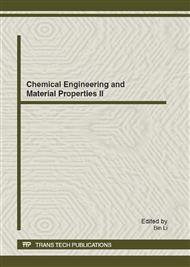[1]
I. C. Eromosele, T. J. Hamgadu: J. Appl. Polym. Sci. Vol. 50 (1993), p.645.
Google Scholar
[2]
C. J. Edgar, C. M. Buchanan, J. S. Debenham, P. A. Rundquist, B. D. Seiler, M. C. Shelton: Prog. Polym. Sci. Vol. 26 (2001), p.1605.
Google Scholar
[3]
C. M. Buchanan, R. M. Gardner, R. J. Komarek: J. Appl. Polm. Sci. Vol. 47 (1993), p.1709.
Google Scholar
[4]
R. J. Komarek, R. M. Gardner, C. M. Buchanan, S. C. Gedon: J. Appl. Polm. Sci. Vol. 50 (1993), p.1739.
Google Scholar
[5]
k. Sakai, T. Yamauch, F. Nakatsu, T. Ohe: Biosci. Biotech. Biochem. Vol. 60 (1996), p.1617.
Google Scholar
[6]
M. Yoshioka, N. Hagiwara, N. Shiraishi: Cellulose Vol. 6 (1999), p.193.
Google Scholar
[7]
Y. Nishio, J. F. Kenedy, G. O. Phillips, P. A. Williams, in: Wood Processing and Utilization; Ellis Horwood: New York, 1989; p.251.
Google Scholar
[8]
Y. Teramoto, M. Yoshioka, N. Shiraishi, Y. Nishio: J. Appl. Polym. Sci. Vol. 84 (2002), p.2621.
Google Scholar
[9]
Y. Miyashita, T. Suzuki, Y. Nishioka: Cellulose Vol. 9 (2002), p.215.
Google Scholar
[10]
Y. Nishioka, K. Matsuda, Y. Miyashita, N. Kimura, H. Suzuki: Cellulose Vol. 4 (1997), p.131.
Google Scholar
[11]
M. Yoshika, N. Hagiwara, N. Shiraishi: Cellulose Vol. 6 (1999), p.193.
Google Scholar
[12]
M. Yoshika, K. Okajima, T. Miyazaki, N. Shiraishi: J. Wood Sci. Vol. 46 (2000), p.22.
Google Scholar
[13]
H. Hatakeyana, T. Yoshida, T. Hatakeyama: J. Therm. Anal. Calorim. Vol. 59 (2000), p.157.
Google Scholar
[14]
Y. Teramoto, M. Yoshika, N. Shiraishi, Y. Nishio: J. Appl. Polym. Sci. Vol. 84 (2002), p.2621.
Google Scholar
[17]
Y. Teramoto, Y. Nishio: Polymer Vol. 44 (2003), p.2701.
Google Scholar
[18]
K. K. Yang, X. L. Wang, Y. Z. Wang: J. Macromol. Sci. Polym. Rev. Vol. C42 (2002), p.373.
Google Scholar
[19]
S. C. Chen, X. L. Wang, Y. Z. Wang, K. K. Yang, Z. X. Zhou, G. Wu: J. Biomed. Mater. Res. Part A Vol. 82A (2007), p.453.
Google Scholar
[20]
G. Y. Liu, Y. L. Zhai, X. L. Wang, W. T. Wang, Y. B. Pan, X. T. Dong, Y. Z. Wang: Carbohydr. Polym. Vol. 74 (2008), p.862.
Google Scholar
[21]
R. He,; X. L. Wang, Y. Z. Wang, K. K. Yang, J. B. Zeng, S. D. Ding: Carbohydr. Polym. Vol. (2006), p.28 Table 1 Effect of the intrinsic viscosities of the PPDOs on the coupling reaction CDA/PPDO (g/g) Reaction Time (h) Reaction Temperature (℃).
Google Scholar


